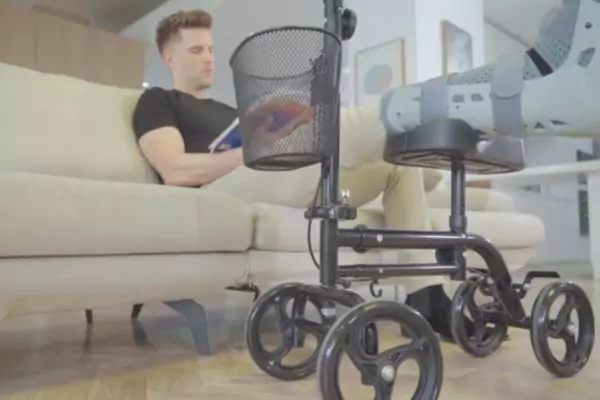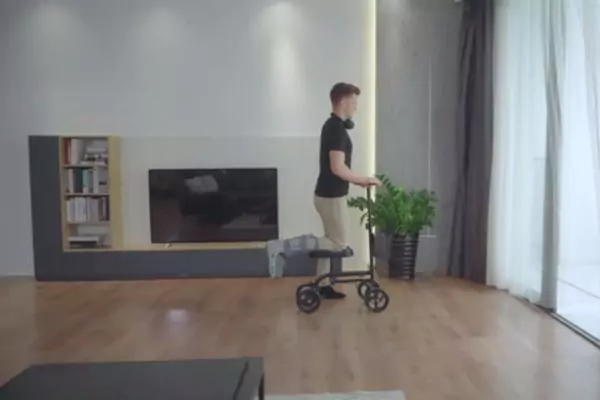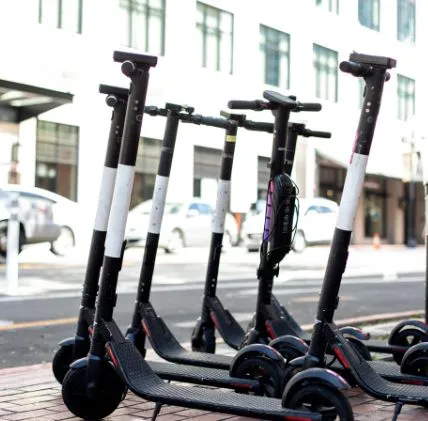Are you recovering from a foot or ankle injury and finding it challenging to move around? Look no further! In this comprehensive guide, we will walk you through the process of using a knee scooter to regain your mobility and independence. Whether you’re a first-time user or seeking tips for a more comfortable experience, we’ve got you covered. Let’s dive in and discover the ins and outs of using a knee scooter effectively.
Contents
How to Use a Knee Scooter: The Basics
What is a Knee Scooter?

Before we delve into the specifics of using a knee scooter, let’s begin by understanding what it actually is. A knee scooter, also known as a knee walker, is a mobility aid designed to assist individuals with lower leg injuries or surgeries. It provides support and stability while allowing the user to navigate with ease, thanks to its innovative design and features.
How Does a Knee Scooter Work?
A knee scooter features a handlebar for steering, a platform to rest your injured leg, and wheels that enable smooth movement. By placing your injured leg on the platform, you can propel yourself forward by pushing off the ground with your non-injured leg. This mechanism provides a comfortable and efficient alternative to crutches, making it an ideal choice for those seeking increased mobility during their recovery process.
Choosing the Right Knee Scooter
Selecting the right knee scooter is crucial for a seamless experience. Here are a few factors to consider when making your decision:
- Weight Capacity: Ensure that the knee scooter you choose can support your weight comfortably. It’s important to check the manufacturer’s guidelines to avoid any risks or complications.
- Adjustability: Look for a knee scooter that offers adjustable features such as handlebar height and knee platform height. These adjustments allow for a customized fit and enhanced comfort.
- Braking System: Check if the knee scooter has a reliable braking system to ensure your safety and stability while maneuvering.
- Portability: If you’re planning to travel or need to transport the knee scooter frequently, opt for a lightweight and foldable model for easy portability.
- Reviews and Ratings: Research and read reviews from other users to gain insights into the quality and performance of different knee scooter models.
How to Use a Knee Scooter Safely and Effectively?

Now that we have covered the basics, let’s explore the step-by-step process of using a knee scooter:
1. Familiarize Yourself with the Knee Scooter
Before hopping on the knee scooter, take a moment to familiarize yourself with its various components. This will ensure that you understand how it works and can make necessary adjustments for your comfort.
2. Adjust the Knee Platform Height
Proper adjustment of the knee platform height is essential for maintaining a comfortable and ergonomic position. Follow these steps to adjust it correctly:
- Locate the adjustment knob or lever near the knee platform.
- Loosen the knob or release the lever to allow vertical movement.
- Position the knee platform at a height that aligns with your injured leg.
- Tighten the knob or secure the lever to lock the platform in place.
3. Set the Handlebar Height
Adjusting the handlebar height ensures that you can maintain proper posture and control while using the knee scooter. Here’s how to do it:
- Locate the adjustment knob or lever on the handlebar stem.
- Loosen the knob or release the lever to allow vertical movement.
- Position the handlebar at a height that allows your arms to be comfortably bent at a 15 to 30-degree angle.
- Tighten the knob or secure the lever to lock the handlebar in place.
4. Mounting and Dismounting the Knee Scooter
Mounting and dismounting the knee scooter correctly is crucial to prevent any mishaps or accidents. Follow these steps for a safe and smooth transition:
- Stand next to the knee scooter and ensure the brakes are engaged.
- Place your non-injured foot securely on the ground.
- Grasp the handlebar for support and stability.
- Slowly lift your injured leg and position it on the knee platform.
- Ensure your injured leg is resting comfortably and securely on the platform.
- Release the brakes and use your non-injured foot to propel yourself forward.
Dismounting the knee scooter follows a similar process. Remember to always engage the brakes before attempting to dismount.
5. Maneuvering and Steering
Mastering the art of maneuvering and steering your knee scooter will allow you to navigate effortlessly. Follow these tips for smooth and controlled movements:
- Keep your body weight centered over the knee scooter to maintain balance.
- Push off the ground with your non-injured leg to generate forward momentum.
- Use the handlebar to steer by gently shifting your weight and applying pressure in the desired direction.
- Practice turning in wide arcs initially to get a feel for the scooter’s maneuverability.
- Slow down when approaching corners or uneven surfaces to ensure stability.
6. Overcoming Challenges and Obstacles
Using a knee scooter may present certain challenges, especially when encountering uneven terrain or obstacles. Here are a few tips to help you overcome these hurdles:
- Approach uneven surfaces, such as ramps or curbs, at a slow and controlled pace.
- Use caution when navigating over bumps, cracks, or gravel to maintain stability.
- Consider using a knee scooter with larger wheels for enhanced maneuverability over rough terrain.
- If faced with a tall obstacle, such as a step or staircase, seek assistance or consider using an alternative mobility aid temporarily.
Frequently Asked Questions (FAQs)
Can I use a knee scooter on the stairs?
No, knee scooters are not designed for use on stairs. It is essential to find alternative methods, such as using crutches or seeking assistance, when encountering staircases or steps.
Is a knee scooter suitable for everyone?
While knee scooters offer a convenient mobility solution for many individuals, they may not be suitable for everyone. It’s crucial to consult with your healthcare provider to determine if a knee scooter is the right choice for your specific condition and recovery process.
Can I sit on a knee scooter?
Most knee scooters are not designed for sitting. However, some models offer a detachable basket or a padded seat accessory for short periods of rest. Refer to the manufacturer’s guidelines for information on using your knee scooter for sitting.
How do I maintain and clean my knee scooter?
To ensure optimal performance and longevity of your knee scooter, follow these maintenance and cleaning tips:
1. Regularly inspect the wheels, brakes, and frame for any signs of wear or damage.
2. Keep the wheels clean and free from debris to maintain smooth movement.
3. Lubricate the moving parts, such as the wheels and handlebar joints, as per the manufacturer’s instructions.
4. Clean the knee platform and handlebar grips with mild detergent and warm water.
5. Avoid exposing your knee scooter to extreme temperatures or moisture.
Can I use a knee scooter indoors and outdoors?
Yes, knee scooters are designed for both indoor and outdoor use. However, be cautious when maneuvering outdoors, as uneven terrain and obstacles may pose challenges. Always prioritize your safety and adjust your speed accordingly.
Final Thoughts
Using a knee scooter can significantly improve your mobility and independence while recovering from a foot or ankle injury. By following the proper techniques and safety guidelines outlined in this guide, you can make the most of your knee scooter experience. Remember to choose a knee scooter that suits your needs, make necessary adjustments for comfort, and practice maneuvering to ensure a smooth ride. With patience and perseverance, you’ll be well on your way to a speedy recovery!


